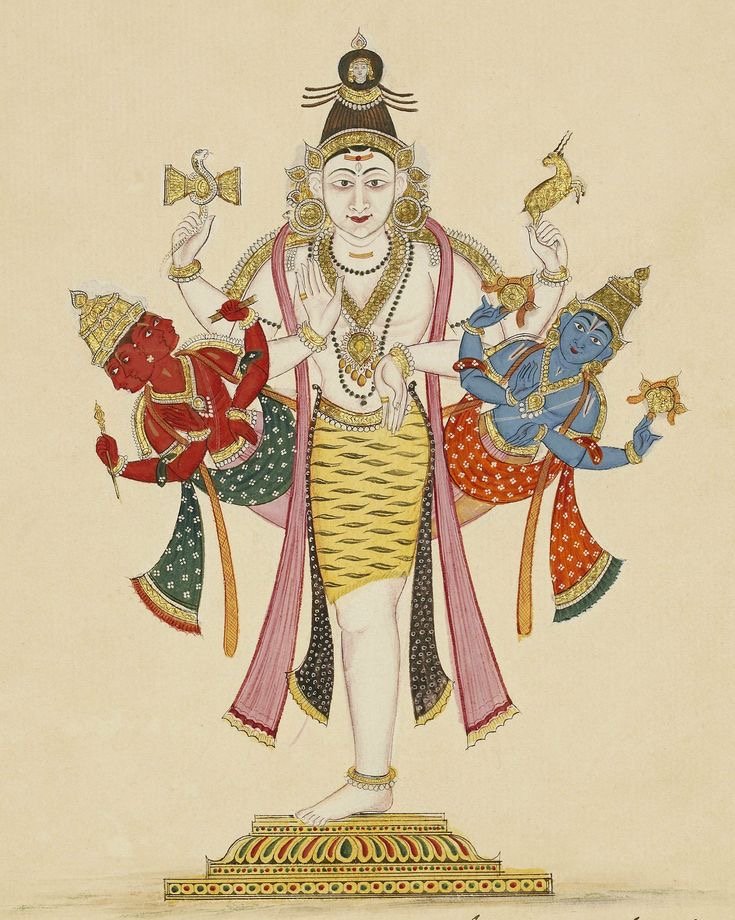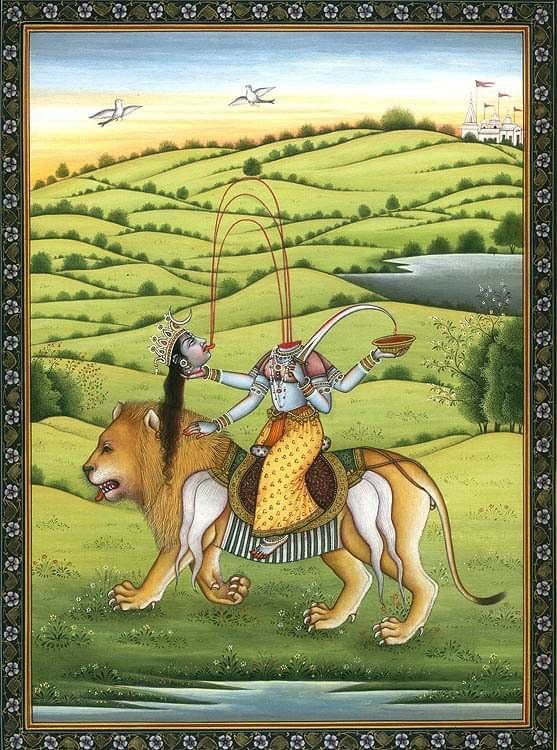Rahu in Pūrvabhādrapadā
Artwork: Pinterest
March 16 — November 23rd
The chāyā (shadowy) graha Rāhu, depicted as mounted on a lion, bluish-black and smoke in color, residing in the forest, the renovator and eclipser of the luminaries, enters the Vedic Lunar Mansion of Pūrva Bhādrapadā पूर्वभाद्रपदा (Pisces), the Scorching Star, on March 16th.
To understand Rāhu graha a little more, we can look to the narrative of the hero’s journey and to the life of Varāha Avatār, the third incarnation of the daśāvatār of Lord Viṣṇu (the preserver and protector), the wild boar. Varāha Dev is one of the four full Paramātmās whose story narrates how Lord Viṣṇu came to rescue Bhūdevī (Pṛthvī), Earth, and restore her to her rightful place in the universe.
Rāhu is the karaka (significator) for justice, courage, truth, self-sacrifice, renovation, risking one’s life for a cause, going against the established order, the foreigner, and the protector of the Earth. With his tusks, Varāha is said to have the ability to dig up any impurities in the heart.
Pūrva Bhādrapadā is symbolized by metamorphosis, rebirth, tapas (penance), perseverance, and the undifferentiated fire energy that has the capacity to raise our consciousness. This constellation, being one of the birth stars of Mercury, represents the chaos and turmoil of fragmentation that births the wisdom of neutrality.
The Burning Pair’s deity (Aja Ekapāda) stands on one leg and has two heads—split yet able to see in both directions. Pūrva Bhādrapadā seeks to bridge heaven and earth, possessing the power to elevate and sacrifice (Yajamana Udyamana Śakti)
Pūrvabhādrapadā initiates an alchemical process where discipline and renunciation refine raw potential into awakened wisdom. This nakṣatra does not merely demand confrontation with duality; it invites us into a dance of integration, where material ambition and spiritual transcendence find their rightful place.
How we manage vast reservoirs of life force energy becomes the defining arc of this cycle, shaping our capacity to channel intensity into focused intention. Yet, the cultivation of inner contentment amidst this dynamic flux is equally vital.
This sacrifice channels energy that can produce and draw down spiritual blessings. Through tapasya (austerity), this energy rises to melt and dissolve the veils obscuring the hidden moon within our minds, showering us with grace.
As Rāhu enters Pūrvabhādrapadā, symbolized by a funeral pyre, we stand at the precipice of transformation, where the purifying fire of Rūdra (fierce form of Śiva) dissolves illusion. While Rāhu’s presence here may manifest through sudden and unpredictable karma-phala (fruits of action), it ultimately compels a dismantling of rigid ideologies, allowing limitation to be transmuted into higher understanding.
Artwork: Pinterst
This is a cycle of intensity, yet not one of inevitable destabilization. The presence of Rāhu here is the ascetic who must temper his fire, the revolutionary who must refine his vision. Discernment (Viveka) becomes paramount, guiding us to differentiate between the higher call of dharma and the consuming hunger for dominion—whether material, intellectual, or ideological.
Rāhu amplifies an insatiable drive for knowledge, power, and ultimate truth, compelling us to navigate the razor’s edge of profound revelation and self-mastery. Those attuned to this energy may find themselves positioned at the forefront of social reform, philosophical inquiry, or disciplined spiritual practice.
The challenge—and the opportunity—is to ensure that transformation does not become an all-consuming blaze, but rather a luminous beacon. When tempered with humility, this fire does not devour but illuminates, revealing the path to higher realization and authentic awakening.
Those running a Dasha or sub-period of Jupiter or Rāhu, or with natal planets in Pūrva Bhādrapadā, will feel this transit's transformative energy even more profoundly.
This cycle will be defined by the goals you set for yourself and what you are willing to give away.
In the planetary protection mantras, we invoke Rāhu to protect our tongue.
For those navigating the depths of this transit, I offer one-on-one Vedic Astrology readings—guiding you through its unfolding with clarity and support. You can book here:
ॐ राम राहवे नमः | ॐ वराहाय नमः
All My Relations






